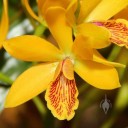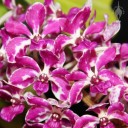Cultivar Names
An orchid name tag may include a cultivar name, which recognizes an interesting or exceptional plant line. The word “cultivar” is a contraction of “cultivated variety.” Properly written, it’s capitalized within single quotes. These 3 beauties provide our examples:
- Cymbidium Lotza Spotz ‘Jacob’
- Epicattleya Chic ‘Zebra’
- Rhynchostylis gigantea ‘Spots’
Cymbidium Lotza Spotz ‘Jacob’ is a hybrid with the cultivar name ‘Jacob’. When grown from seed, each plant has a different genetic mix than its siblings, and each produces a slightly different flower. Orchid breeders can give a cultivar name to any individual plant with desirable traits. Other siblings from the cross of those same hybrid parents can receive their own cultivar names. Siblings in this line include Cymbidium Lotza Spotz ‘Rome’ and Cymbidium Lotza Spotz ‘Mac’.
The orange and red Epicattleya Chic ‘Zebra’ is a hybrid with the cultivar name ‘Zebra’. Contrasting stripes on the flower lip may have inspired the choice of ‘Zebra’. A plant may be worthy of a cultivar epithet if it has attractive colors, abundant blooms, or vigorous growth. The International Code of Nomenclature for Cultivated Plants (ICNCP) regulates these names.
Rhynchostylis gigantea ‘Spots’ is a species with larger-than-usual purple spots, which is a naturally-occurring mutation. Natural variations occur in all plants, and plant vigor, color patterns, or flower shapes may vary within the same species. If it’s not distinct enough to be a different species, it’s considered a variant. Any single plant may exhibit these deviations, and an orchid grower may give it a distinguishing name, like ‘Spots’.
If a cultivar wins an award, that award becomes part of its name. For example, Zygopetalum BG White ‘Stonehurst’ HCC/AOS (Highly Commended Certificate/American Orchid Society) boasts its status as a winner.
Because a cultivar is a distinct genetic strain, it can only be reproduced by cloning, divisions, or keikis. As exact copies, they carry the cultivar name. However, crossbreeding with another orchid would create a different hybrid, since the offspring would have a different genetic makeup. The cultivar name would not apply to these descendants.
Explore posts in the same categories: Orchid Names, Photos
Subscribe to the About Orchids Blog:
![]()



August 9th, 2011 at 6:40 pm
Dude, a wondrful job. Super helpful information.
August 11th, 2011 at 1:58 pm
Hello! Just want you to know that I really found this website really helpful to me. I will come back to this blog more often to read more. Thanks.
August 18th, 2011 at 9:34 pm
I learned a lot from this post, great help for me, thank you!
September 3rd, 2011 at 11:12 am
Good info. Sometimes I just look at a nametag and its all Greek to me! This is helpful to make sense of it all.
September 18th, 2011 at 7:32 am
I still don’t know what you mean.
October 15th, 2011 at 12:18 pm
Thank you so very much. I’ve been growing orchids for years, but I never understood everything on the name tag. I always used to wonder what that name in quotes was. I found an explanation in a book once, but it didn’t make any sense to me. Your explanation makes sense to me. Thanks again!
December 14th, 2011 at 10:23 pm
[…] These 3 cultivars have received prizes: […]